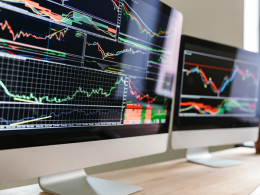The following chart (courtesy of Bill Hester) presents the ratio of the cyclicals index (CYC) versus the staples index (CMR). It's notable that the most recent spike in this ratio coincided with Bernanke's initial announcement of QE2. Cyclicals are now nearly as overextended relative to staples as they were at the 2007 peak. As one would infer from the word "cyclical," these companies are unusually prone to volatility.

Just as relevant for investors is the comparative valuation of these groups. The chart below presents the ratio of price/book value for staples relative to cyclicals. Historically, staples have been awarded higher valuations due to their higher and more stable long-term returns on equity. While staples continue to have strong returns on equity, they are strikingly out of favor. On this note, we have to agree with Jeremy Grantham of GMO in observing that high-quality large-caps (and we would emphasize those with stable growth, profit margins and ROE) most likely present the best prospects for total returns in the coming years. These stocks represent a distinct subset of the S&P 500. The constituents of the S&P 500 should not be viewed as a uniform group of "high quality" companies by any means.

Market Climate
As of last week, the Market Climate for stocks was characterized by an overvalued, overbought, overbullish, rising-yields syndrome that has historically been hostile for stocks. Clearly, we can't observe what the outcome will be in this particular instance. We can't rule out the possibility that investors will continue to speculate on the hope of ever larger deficits and some further combination of illegal or irresponsible Fed actions. From our standpoint, the return/risk profile of the equity market is the most negative that we ever observe historically, so we are willing to speculate neither on the hope for government wisdom, nor on the hope for government recklessness. Investors who are convinced that monetary and fiscal actions will drive the market ever higher can easily offset our hedges by establishing exposure to the S&P 500 or more speculative alternatives. What I can't do on behalf of those investors is violate our discipline and take a speculative exposure in an environment where the historical evidence indicates an extraordinarily hostile return-to-risk tradeoff.
Our objective remains to significantly outperform our benchmarks over the complete market cycle, with smaller periodic losses. I recognize that it has not been satisfactory simply to lose less than the S&P, but with smaller drawdowns, since the 2007 peak. Still, it would be an understatement to say this has been an unusual cycle. Given the broader set of Market Climates we have defined, I am confident that we will periodically observe more favorable market environments - possibly even in the coming months, without major changes in market valuation - where we will be able to accept risk in the expectation of positive returns. From my perspective, this is emphatically not one of them.
The Strategic Growth Fund remains fully hedged here. Given the hostile Market Climate, and the fact that individual stocks can decline indiscriminately from overvalued, overbought, overbullish, rising-yield peaks, we are also carrying a staggered strike hedge (which moves our put option strikes closer to "at-the-money" levels). Though we expect to close that position at the point where the return/risk profile of the market improves or implied option volatility increases significantly, the last thing we want is to be inadequately hedged in an indiscriminate selloff because we believed our stocks did not have much "beta." Strategic International Equity is also largely hedged, and we continue to establish corresponding hedges as we add new equity positions to the Fund.
In bonds, the Market Climate last week was characterized by slightly favorable yield levels, but unfavorable yield pressures. In response to a sharp spike in Treasury yields, we increased the Strategic Total Return Fund's duration to about 2.5 years from just under 1 year. This clearly isn't an aggressive shift by any means, and may only be a brief change, but we'll respond to the evidence as it emerges. I suspect that it may take longer for deficit spending and monetary ease to result in inflation than the market presently appears to be pricing in.
Based on historical experience, we are likely to observe a clear acceleration of inflation only after short-term interest rates increase by about 15-20 basis points over a 6-month period, and those pressures will be worse if long-term rates are also rising (at that point, attempts to reduce short rates through Fed easing may have the paradoxical effect of increasing inflation expectations). For now, I continue to believe that the inflation thesis is most likely correct long-term, but that this doesn't necessarily translate into persistent inflation or interest rate pressures over the short or intermediate term. We continue to hold about 1% of assets in precious metals, about 1% in foreign currencies, and about 2% in utility shares.
Copyright (c) Hussman Funds












